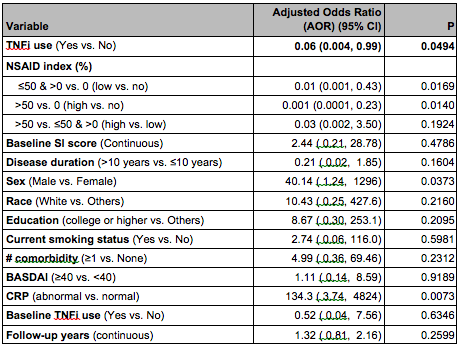Session Information
Date: Monday, November 14, 2016
Title: Spondylarthropathies Psoriatic Arthritis – Pathogenesis, Etiology - Poster I
Session Type: ACR Poster Session B
Session Time: 9:00AM-11:00AM
Background/Purpose: Ankylosing spondylitis (AS) is a chronic inflammatory arthritis affecting the sacroiliac (SI) joints and spine causing structural changes seen on clinical radiography. Studies have suggested that NSAID and TNF inhibitor (TNFi) use slow down new bone formation. We evaluated the impact of TNFi treatment on the evolution of radiographic changes in the SI joints in a large and well-characterized long term follow-up cohort and to determine whether TNFi use, over an extended period of time, can have an effect on radiographic change in the SI joints.
Methods: All AS patients satisfying the modified New York criteria prospectively followed, with multiple sets of pelvic radiographs multiple years apart spanning >2 up to >10 years were investigated. Radiographic change and TNFi use in patients with AS and sacroiliitis were assessed. Anteroposterior radiographs of the right and left SI joints were scored by a board certified musculoskeletal radiologist according to the Bath Ankylosing Spondylitis Radiology Index for the spine (BASRI-s). We selected a grade-2 BASRI score change to eliminate concerns associated with reliability for reading a grade-1 score change.
Results: 630 AS patients who met the New York criteria and had at least 2 sets of radiographic SI joint severity data were reviewed. There were 283 patients who initially started with bilateral grade-4 sacroiliitis. Ultimately, 180 patients who initially started either as grade 2 bilaterally or grade-3 on at least 1 side and who could meet these criteria were included in analysis (median follow-up year=3). We conducted multivariable logistic regression model using progression as a dichotomous outcome variable (progressor or non-progressor) to evaluate multivariable associations between TNF-inhibitor use (defined as those who used TNFi for more than 50% of their follow-up period) and SI joint progression after controlling for other factors (including follow-up period, baseline SI joint scores, baseline TNFi use, NSAID index over follow-up period, study sites and clinical/demographic variables such as disease duration, sex, education level, race, current smoking status, subjective disease activity (BASDAI), CRP and comorbidity). Our findings indicate that TNFi use was related to less SI joint progression in AS patients (AOR=0.06, 95% CI 0.004 to 0.99; p=0.0494). In addition, high and low NSAID use, sex, CRP were significantly associated with lesser SI joint progression and could be potential confounders. No significant interaction was found between NSAID and TNFi use.
Conclusion: TNFi use was associated with less radiographic progression utilizing the BASRI scoring system in a large cohort of AS patients who fulfilled NY criteria at entry and were followed, in many cases, for up to and greater than 10 years. 
To cite this abstract in AMA style:
Minhas D, Lee M, Rahbar MH, Gensler LS, Reveille JD, Weisman M. Do TNF Inhibitors Change the Progression of Sacroiliitis? [abstract]. Arthritis Rheumatol. 2016; 68 (suppl 10). https://acrabstracts.org/abstract/do-tnf-inhibitors-change-the-progression-of-sacroiliitis/. Accessed .« Back to 2016 ACR/ARHP Annual Meeting
ACR Meeting Abstracts - https://acrabstracts.org/abstract/do-tnf-inhibitors-change-the-progression-of-sacroiliitis/
